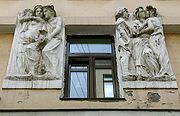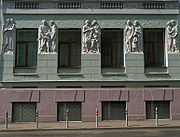
Nikolay Zherikhov
Encyclopedia



Moscow
Moscow is the capital, the most populous city, and the most populous federal subject of Russia. The city is a major political, economic, cultural, scientific, religious, financial, educational, and transportation centre of Russia and the continent...
) was a Russian Art Nouveau
Art Nouveau
Art Nouveau is an international philosophy and style of art, architecture and applied art—especially the decorative arts—that were most popular during 1890–1910. The name "Art Nouveau" is French for "new art"...
architect, active in Moscow in 1902–1914. A prolific author of apartment buildings financed by Broido, Wilner and Zaichenko real estate firms, Zherikhov stood out among contemporary architects for his use of decorative sculpture
Sculpture
Sculpture is three-dimensional artwork created by shaping or combining hard materials—typically stone such as marble—or metal, glass, or wood. Softer materials can also be used, such as clay, textiles, plastics, polymers and softer metals...
. Zherikhov's buildings are adorned with rows of life-sized figurative sculptures, including one extant case of explicit erotic art
Erotic art
Erotic art covers any artistic work that is intended to evoke erotic arousal or that depicts scenes of love-making. It includes paintings, engravings, drawings, sculptures, photographs, music and writing.-Definition:...
at no. 4, Plotnikov Lane.
Biography
Nikolay Zherikhov was born in a poor peasant family in Mahilyow area; exact date of his birth (1870s) and his education (probably Stroganov Institute) remain unknown. In 1897–1900 Zherikhov worked as drawing and writing teacher in Moscow schools; his first architectural work was made in 1902 for the Broidos, a Jewish family of real estate developers. His two brothers graduated from Moscow School of Painting, Sculpture and ArchitectureMoscow School of Painting, Sculpture and Architecture
The Moscow School of Painting, Sculpture and Architecture was one of the largest educational institutions in Russia. The school was formed by the 1865 merger of a private art college, established in Moscow in 1832, and the Palace School of Architecture, established in 1749 by Dmitry Ukhtomsky. By...
; they collaborated with Nikolay but did not leave a notable contribution of their own. Zherikhov himself never participated in public professional disputes; his name and works were neglected by the press. His road to success remains a mystery; Zherikhov, once an ordinary teacher, instantly became a fashionable architect and authored over 50 buildings in affluent districts of Moscow in twelve years of his short career.
His use of sculpture has been linked to the legacy of Stroganov Institute school that focused on elaborate facade decorations. However, none of contemporary architects used sculpture so frequently and on such scale as Zherikhov. His best known work, a small 4-story apartment building on the corner of Plotnikov and Maly Mogiltsevsky Lane, completed in 1907, features a band of 40 life-sized figures arranged in groups of two or three in explicitly erotic settings. Three of the satyr
Satyr
In Greek mythology, satyrs are a troop of male companions of Pan and Dionysus — "satyresses" were a late invention of poets — that roamed the woods and mountains. In myths they are often associated with pipe-playing....
s resemble Leo Tolstoy
Leo Tolstoy
Lev Nikolayevich Tolstoy was a Russian writer who primarily wrote novels and short stories. Later in life, he also wrote plays and essays. His two most famous works, the novels War and Peace and Anna Karenina, are acknowledged as two of the greatest novels of all time and a pinnacle of realist...
, Alexander Pushkin and Nikolay Gogol. The name of the sculptor has been lost; perhaps it was Leeb Sinayev, author of Pushkin Museum
Pushkin Museum
The Pushkin Museum of Fine Arts is the largest museum of European art in Moscow, located in Volkhonka street, just opposite the Cathedral of Christ the Saviour....
friezes, or one of his disciples. Tourist guides say that the building once housed a high-class brothel
Brothel
Brothels are business establishments where patrons can engage in sexual activities with prostitutes. Brothels are known under a variety of names, including bordello, cathouse, knocking shop, whorehouse, strumpet house, sporting house, house of ill repute, house of prostitution, and bawdy house...
, but the statement is refuted by historians as an urban legend
Urban legend
An urban legend, urban myth, urban tale, or contemporary legend, is a form of modern folklore consisting of stories that may or may not have been believed by their tellers to be true...
.
Zherikhov, like contemporary Gesamtkunstwerk
Gesamtkunstwerk
A Gesamtkunstwerk is a work of art that makes use of all or many art forms or strives to do so...
architects, practiced application of the exterior style to building interiors, including individual apartment units. Around 1910, following the trend of the time, he switched to Russian neoclassical revival
Russian neoclassical revival
Russian neoclassical revival was a trend in Russian culture, mostly pronounced in architecture, that briefly replaced eclecticism and Art Nouveau as the leading architectural style between the Revolution of 1905 and the outbreak of World War I, coexisting with the Silver Age of Russian Poetry...
; his best known example of the period is the Flyorov School, now a college of Moscow Conservatory
Moscow Conservatory
The Moscow Conservatory is a higher musical education institution in Moscow, and the second oldest conservatory in Russia after St. Petersburg Conservatory. Along with the St...
, in Merzlyakovsky Lane. Here the sculpture follows the classical Roman canon. Like many Art Nouveau architects of his period he also practised earlier Victorian architecture
Victorian architecture
The term Victorian architecture refers collectively to several architectural styles employed predominantly during the middle and late 19th century. The period that it indicates may slightly overlap the actual reign, 20 June 1837 – 22 January 1901, of Queen Victoria. This represents the British and...
, evident in his 1914 Solovyov Clinic on present-day New Arbat Street
New Arbat Street
New Arbat Avenue is a major street in Moscow running west from Arbat Square on the Boulevard Ring to Novoarbatsky Bridge on the opposite bank of the Moskva River...
.
The architect died in his forties, in 1916, and was buried at Vagankovo Cemetery
Vagankovo Cemetery
Vagan'kovskoye Cemetery , established in 1771, is located in the Krasnaya Presnya district of Moscow...
.

